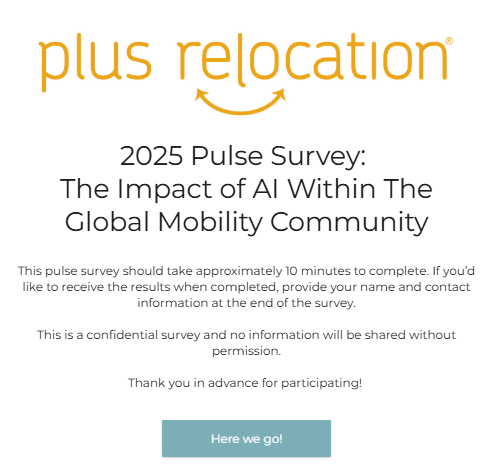Global mobility programs are often an extension of HR and talent functions, but they operate in a unique, high-stakes environment—one where compliance, employee experience, and global coordination all converge. A recent HR Executive article, “Beyond the buzz: Why a ‘careful pace’ on AI adoption can scale HR’s impact”, offers valuable insights into how HR leaders are approaching AI adoption. By viewing these findings through a mobility lens, we can better understand where our industry aligns with HR’s path—and where our challenges and opportunities diverge.
HR’s “Careful Pace” and Mobility’s Reality
The HR Executive article notes that while AI generates tremendous interest, true enterprise-wide adoption remains limited—only 27% of organizations have achieved it, with another 33% still at departmental or project levels. This measured pace is not a sign of reluctance, but of strategic intent: ensuring AI supports business goals, aligns with talent strategies, mitigates risk, and works within existing systems.
For global mobility, that “careful pace” is often even more necessary. In addition to HR’s concerns, mobility teams must navigate multiple regulatory environments, cross-border data privacy requirements, and a complex web of suppliers and partners. Moving too fast with untested AI tools could create exposure in areas like immigration compliance, tax filings, and personal data protection.
The Three Capabilities HR Is Building—and How Mobility Fits
The HR Executive article highlights three capabilities HR must develop to scale AI impact. Each has clear mobility parallels:
- Enterprise Operating Model for AI – HR leaders are mapping how AI reshapes business models and workforce needs. For mobility, this means assessing how AI can optimize assignment planning, cost projections, and location selection—while ensuring that automation still supports a personalized employee experience.
- Strategic AI Governance – HR is defining policies and accountability across IT, finance, and legal. Mobility governance must also include external partners—relocation management companies, immigration providers, tax firms—so AI use is consistent and compliant across the entire service chain.
- Proactive Risk Management – HR is preparing for risks like “bring-your-own-AI” and skill shifts. In mobility, that risk extends to unvetted tools processing sensitive documents like passports or visas, where even minor errors or data leaks can have major consequences.
Familiarity vs. Adoption
The article notes a disconnect between personal and workplace AI adoption: employees may use AI in daily life but hesitate professionally due to unclear expectations, mistrust, or privacy concerns. In global mobility, this hesitation can be amplified by the high stakes—people are more cautious about letting AI touch processes that impact an assignee’s legal status or family relocation. Building trust will require clear communication on what AI is doing, how it’s supervised, and why it’s beneficial for assignees.
The Agile, Talent-Centric Model—Applied to Mobility
HR is envisioning a future talent model blending employees, contractors, outsourced providers, and AI. In mobility, this could translate to:
- AI handling repetitive data gathering (e.g., policy comparisons, shipment tracking updates)
- Human experts focusing on complex problem-solving, cultural support, and relationship management
- A more agile response to sudden business needs, such as new market entries or global crises
This blended model could increase scalability and responsiveness while maintaining the personal touch mobility is known for.
Governance as a Success Foundation
The article emphasizes governance not just as risk control, but as a foundation for innovation. For mobility, a strong AI governance framework would cover ethics, clear ownership between HR and mobility, evaluation protocols, vendor standards, and continuous training—ensuring AI enhances, rather than disrupts, the relocation experience.
Why Plus Relocation Is Taking the Pulse on AI in Mobility
Many of the adoption dynamics HR is experiencing are emerging in global mobility—but our function’s cross-border scope, compliance demands, and people-centric nature create distinct challenges and opportunities. That’s why Plus Relocation is running its second annual survey on AI in mobility:
2025 Pulse Survey: The Impact of AI Within the Global Mobility Community
This quick survey explores several key areas:
- The level of AI usage in mobility programs
- Tasks and functions where AI is being applied
- Perceptions of AI’s current and future impact
- Overall sentiment toward AI in the mobility space

Your input will help benchmark where our industry is today and guide strategies for where we go next.



/Passle/56686a093d94740bd0dda608/SearchServiceImages/2025-12-17-17-08-17-606-6942e3816438b978e7e92a33.jpg)
/Passle/56686a093d94740bd0dda608/SearchServiceImages/2025-12-09-13-15-25-863-693820ed973b7bf3db12c7cb.jpg)
/Passle/56686a093d94740bd0dda608/SearchServiceImages/2025-12-10-22-04-18-636-6939ee623022ad2765805b8a.jpg)